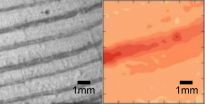Dead galaxies in Coma Cluster may be packed with dark matter
2015-07-20
(Press-News.org) Galaxies in a cluster roughly 300 million light years from Earth could contain as much as 100 times more dark matter than visible matter, according to an Australian study.
The research, published today, used powerful computer simulations to study galaxies that have fallen into the Coma Cluster, one of the largest structures in the Universe in which thousands of galaxies are bound together by gravity.
"It found the galaxies could have fallen into the cluster as early as seven billion years ago, which, if our current theories of galaxies evolution are correct, suggests they must have lots of dark matter protecting the visible matter from being ripped apart by the cluster."
Dark matter cannot be seen directly but the mysterious substance is thought to make up about 84 per cent of the matter in the Universe.
International Centre for Radio Astronomy Research PhD student Cameron Yozin, who led the study, says the paper demonstrates for the first time that some galaxies that have fallen into the cluster could plausibly have as much as 100 times more dark matter than visible matter.
Yozin, who is based at The University of Western Australia, says the galaxies he studied in the Coma Cluster are about the same size as our own Milky Way but contain only one per cent of the stars.
He says the galaxies appear to have stopped making new stars when they first fell into the cluster between seven and ten billion years ago and have been dead ever since, leading astrophysicists to label them "failed" galaxies.
This end to star formation is known as "quenching".
"Galaxies originally form when large clouds of hydrogen gas collapse and are converted to stars--if you remove that gas, the galaxy cannot grow further," Yozin says.
"Falling into a cluster is one way in which this can happen. The immense gravitational force of the cluster pulls in the galaxy, but its gas is pushed out and essentially stolen by hot gas in the cluster itself.
"For the first time, my simulations have demonstrated that these galaxies could have been quenched by the cluster as early as seven billion years ago.
"They have however avoided being ripped apart completely in this environment because they fell in with enough dark matter to protect their visible matter."
This research was motivated by the recent observational discovery of these galaxies by an American and Canadian team led Professor Pieter van Dokkum of Yale University.
Using the data the North American team published last year, Yozin was able to create computer simulations to model how the galaxies evolved into what we can see today.
INFORMATION:
The study was released in the journal Monthly Notices of the Royal Astronomical Society, published by Oxford University Press.
Further Information:
ICRAR is a joint venture between Curtin University and The University of Western Australia with support and funding from the State Government of Western Australia.
Original publication details:
'The quenching and survival of ultra-diffuse galaxies in the Coma cluster' in Monthly Notices of the Royal Astronomical Society. Published online on 20/7/2015 at: http://mnras.oxfordjournals.org/lookup/doi/10.1093/mnras/stv1073
Supporting Multimedia:
High resolution images are available from the following link. http://www.icrar.org/comacluster
Contact Details:
Cameron Yozin (ICRAR - UWA)
Ph: +61 8 6488 3819 E: cameron.yozin-smith@icrar.org M: +61 423 941 128
Pete Wheeler (Media Contact, ICRAR)
Ph: +61 8 6488 7758 E: pete.wheeler@icrar.org M: +61 423 982 018
UWA Media Office
Ph: +61 8 6488 3229 E: uwamedia@uwa.edu.au
[Attachments] See images for this press release:


ELSE PRESS RELEASES FROM THIS DATE:
2015-07-20
A new drug acts as a roadblock for malaria, curing mice of established infection, according to a study in The Journal of Experimental Medicine. Treatment was not associated with obvious side effects, suggesting that the drug may also be safe and effective in humans.
Nearly 200 million cases of malaria occur worldwide each year, and roughly 500,000 people (mostly African children) die of the disease. Malaria is caused by infection with the parasite Plasmodium falciparum (Pf), and although the disease can be treated with anti-malarial drugs, the drugs are harsh and resistance ...
2015-07-20
PORTLAND, Ore., July 20, 2015 -- More than half of chronic pain patients in a managed care setting reported using chiropractic care or acupuncture or both, but many of these patients didn't discuss this care with their primary care providers. These study results, published today in the American Journal of Managed Care, suggest that better care coordination is needed among patients and physicians.
Researchers surveyed more than 6,000 patients in Oregon and Washington who were Kaiser Permanente members from 2009 - 2011 and had three or more outpatient visits for chronic ...
2015-07-20
Berkeley -- It might not be long before consumers can just hit "print" to create an electronic circuit or wireless sensor in the comfort of their homes.
Engineers at the University of California, Berkeley, in collaboration with colleagues at Taiwan's National Chiao Tung University, are expanding the already impressive portfolio of 3D printing technology to include electrical components, such as resistors, inductors, capacitors and integrated wireless electrical sensing systems. They have put the new technology to the test by printing a wireless "smart cap" for a milk ...
2015-07-20
Anyone who's ever noticed a water puddle drying in the sun has seen an environment that may have driven the type of chemical reactions that scientists believe were critical to the formation of life on the early Earth.
Research reported July 15 in the journal Angewandte Chemie International Edition demonstrates that important molecules of contemporary life, known as polypeptides, can be formed simply by mixing amino and hydroxy acids - which are believed to have existed together on the early Earth - then subjecting them to cycles of wet and dry conditions. This simple ...
2015-07-20
The first worldwide study of animals and the seeds they eat has overturned a long-held assumption - that large animals mainly eat large seeds.
The finding by UNSW Australia scientists has implications for conservation showing that a wider variety of plants than is often thought could be at risk if large animals go extinct and do not disperse their seeds.
In a comprehensive study, UNSW's Si-Chong Chen and Professor Angela Moles compiled and analysed data on more than 13,000 animal-seed interactions, based on previously published reports.
"It is the first broad-scale study ...
2015-07-20
Scientists studying thin layers of phosphorus have found surprising properties that could open the door to ultrathin and ultralight solar cells and LEDs.
The team used sticky tape to create single-atom thick layers, termed phosphorene, in the same simple way as the Nobel-prize winning discovery of graphene.
Unlike graphene, phosphorene is a semiconductor, like silicon, which is the basis of current electronics technology.
"Because phosphorene is so thin and light, it creates possibilities for making lots of interesting devices, such as LEDs or solar cells," said lead ...
2015-07-20
The manipulation of light has led to many applications that have revolutionized society through communications, medicine and entertainment. Devices consuming the energy of electromagnetic radiation, such as absorbers and sensors, play an essential role in the using and controlling of light.
The researchers at the Aalto University Department of Radio Science and Engineering have demonstrated the first realization of absorbers that do not reflect light over a wide range of frequencies. All previous absorbers at other frequencies were either fully reflective, as mirrors, ...
2015-07-20
Marine species that already have large ranges are extending their territories fastest in response to climate change, according to new research from University of British Columbia biodiversity experts.
The study is one of the first comprehensive looks at how traits--other than thermal niche--impact marine animals' ability to respond to climate change. It could help improve global predictions of how different species redistribute as the oceans warm, and identify species in greatest jeopardy.
"We have a bit of a mystery as to why some animals are moving quickly into cooler ...
2015-07-20
Wood and its response to stress or strain has been less known at a fundamental level - until now.
The structural properties of brittle materials like rock or ceramic, such as cracking under stress, have long been studied in detail, providing insight into avalanches, earthquakes and landslides. Wood and its response to stress or strain has been less known at a fundamental level - until now.
Scientists, from the Department of Applied Physics at Aalto University in Finland, have applied well-established methods for studying all kinds of materials to wood, namely through ...
2015-07-20
Philadelphia, PA, July 20, 2015 - Exposure therapy is a commonly used and effective treatment for anxiety disorders, including posttraumatic stress disorder, obsessive-compulsive disorder, and phobias.
The goal of such therapy is to extinguish fear, which is accomplished by presenting cues that are known to predict a negative experience in the absence of that experience. Over time, learning that the 'danger cue' is no longer dangerous produces extinction of the fearful response.
However, fears and the associated defensive behaviors resulting from that fear often return ...
LAST 30 PRESS RELEASES:
[Press-News.org] Dead galaxies in Coma Cluster may be packed with dark matter








